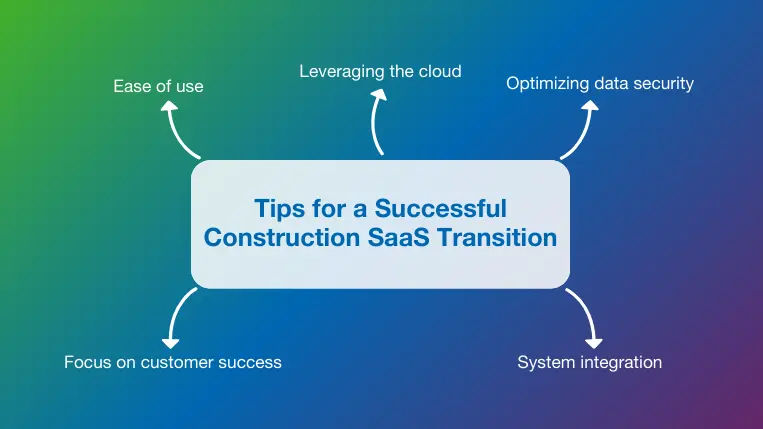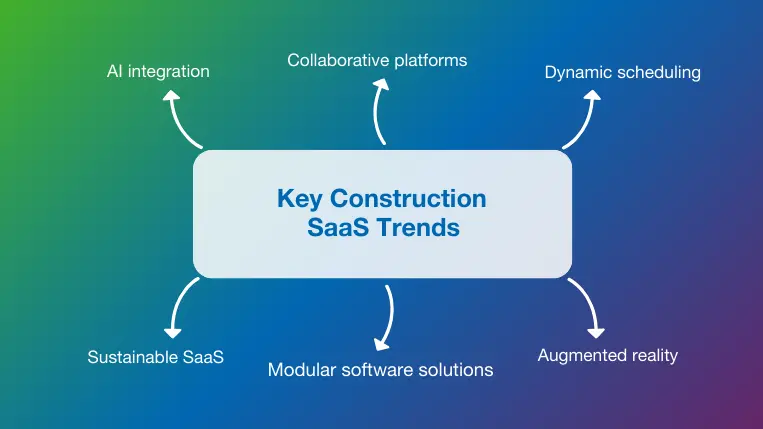11 mins read
Construction SaaS: Important Trends, Challenges, and Best Practices

The construction industry’s digital transformation that began over two decades ago is now in full swing. Many innovative tools and technologies are contributing to this transition, but software as a service is the central element responsible for bringing the benefits of digital technology to construction teams and projects worldwide.
We’ve already discussed the top SaaS trends for 2025 earlier this year. In this blog post, we go deeper and define construction SaaS as we explore the importance and challenges of third-party software in an evolving industry. We also review seven current trends taking SaaS to the next level.
What is Construction SaaS?
Construction software as a service (SaaS) is a distribution model where various valuable software products hosted by third-party providers are made available over the Internet. SaaS has transformed the way construction businesses of all types use and deploy software.
The global construction software market value is expected to double from USD 9.87 billion to over USD 21 billion by 2032. SaaS for construction industry applications encompasses a wide variety of design, scheduling, accounting, project management, and estimating platforms accessible from any location with an internet connection. The real-time updates, data sharing, and analytical capabilities offered by construction SaaS are transforming the industry in many exciting ways.
Why is Construction SaaS Important?
SaaS has reshaped nearly every industry by making software applications more scalable, collaborative, and adaptable. With the added benefits of mobility and connectivity brought by the cloud and wireless technology, SaaS has become an ideal tool for improving data accessibility and communication in construction, where stakeholders might be dispersed throughout the job site or around the world.
Construction SaaS also brings higher levels of scalability and cost-efficiency that could not have been imagined when the first standalone Building Information Modeling (BIM) software packages were introduced almost 50 years ago. SaaS subscription models reduce upfront investment in hardware and licensing while making it easier to scale services up or down, depending on current usage.
SaaS platforms also provide nearly unlimited computing power and storage capacity to improve decision-making and support material procurement, resource management, and project cost analytics.
Common Challenges of SaaS for the Construction Industry
Unlike automated manufacturing, aviation, and other industries that originated in the modern era, the construction industry has evolved over many centuries with ingrained practices based on face-to-face communication and paper-based design and record-keeping processes. This long history has made resistance to change a key obstacle to overcome in moving toward universal SaaS adoption. Additional challenges of SaaS for construction industry applications include:
- Data integration for fragmented records, reports, and drawings
- Lack of customization for specific trades, industries, and functions
- Connectivity issues in remote and isolated project locations
- User access controls for vendors, subcontractors, and consultants
Concerns over cloud security, data privacy, vendor dependence, and technical support are additional issues shared by construction companies considering SaaS options, so overcoming these limitations and perceptions has become a primary goal for third-party software providers.
Tips for a Successful Construction SaaS Transition

Transitioning from decades of manual, siloed practices to cloud-based, centralized construction SaaS solutions can be a difficult task, but one that pays unlimited dividends when it is approached strategically. Focusing on a few important factors helps to make the transition smoother.
Ease of use
Any product or software solution with an easy user experience overcomes resistance more quickly as customers discover the benefits from day one. Rather than abandoning SaaS solutions out of confusion or frustration, users who engage with the software are also more likely to share their recommendations with other stakeholders. Easy-to-use SaaS products also reduce reliance on training programs while attracting users with little or no computer knowledge.
Leveraging the cloud
Cloud connectivity brings added benefits for software users that are not always found in local software packages. Automated updates, real-time data access from anywhere, unlimited scalability, and improved collaboration in construction projects are just a few of the advantages of cloud-based SaaS that are especially important in the building industry, where dispersed teams and complex projects must emphasize data visibility and communication to stay competitive.
Optimizing data security
Security is always a top concern when companies and teams move from local databases and paper records to online systems that can potentially expose sensitive project data. Threat detection tools, access controls, and proper system configuration should be prioritized during SaaS implementation to ensure IT and cybersecurity issues do not undermine a successful transition. Carefully selecting construction SaaS providers with strong cybersecurity policies and practices is another way to mitigate this risk.
System integration
Software packages for project management, estimating, or procurement that cannot integrate with existing systems like accounting, ERP, or customer relationship management (CRM) are limited in value since data will remain siloed, and manual steps will still be necessary to synchronize databases. This limitation can contribute to the resistance that slows adoption, so integration capabilities should always be a critical SaaS consideration.
Focus on customer success
Even with the many benefits for users, focusing on customer satisfaction provides deeper insight into the value of SaaS. Cloud-based systems make giving real-time updates to customers or clients easier, generating timely construction reports, reducing risks, and ensuring projects adhere to contracted schedules and budget requirements. Successful client outcomes bring the positive reviews and repeat business that every construction business wants.
Key Construction SaaS Trends

Software as service trends in the construction industry mirrors the essential SaaS trends we have witnessed across the board, with new technology, market consolidation, and construction sustainability shaping the overall direction of SaaS offerings. As we enter an exciting new era, these developments will significantly impact the future of construction SaaS.
1. AI integration
Adopting artificial intelligence (AI) is one of the most impactful SaaS trends, with many software providers offering generative AI features like Chatbots and Copilots to help users and customers complete their tasks more efficiently. Predictive analytics are another powerful benefit of AI and machine learning capabilities that make construction SaaS tools more efficient and precise for tasks like KPI tracking, contingency planning, and material forecasting.
2. Collaborative platforms
Cloud based construction software solutions provide a centralized location to share and store data, but the full benefits of connectivity are only realized through collaboration. This value is being recognized by construction SaaS providers as they add new features for messaging, real-time alerts, and team communication to their offerings. The benefits of improved collaboration are also extended to clients, contractors, and other stakeholders when they adopt a common SaaS platform.
3. Dynamic scheduling
Scheduling has always been a key element of successful project management in construction, with interdependencies between tasks, resources, equipment, and materials carefully coordinated to optimize productivity. The dynamic scheduling processes made possible by SaaS continually update and adjust schedules based on the continuous flow of real-time project information. Project tasks are reassigned or re-ordered based on the latest conditions and constraints.
4. Augmented reality
SaaS applications that combine real-life images with computer-generated objects are quickly gaining traction. Edge computing and high-speed wireless connectivity eliminate the bandwidth and latency (lag) constraints that once made these systems impractical. The augmented reality market is expected to grow at an annual rate of 37.9% through 2030. Construction SaaS will play a big part in this expansion, with users taking virtual tours of construction sites, identifying hazards, and conducting safety training in the digital realm.
5. Modular software solutions
Market consolidation has seen larger SaaS providers add more features and options to their standard products. Still, niche markets and customers with targeted needs highlight the benefits of modular construction SaaS solutions. For example, customers can gradually add project management, quantity takeoff & estimation, bid management, and procurement modules to their subscription portfolio, with each new module seamlessly integrating with the data and features of the others.
6. Sustainable SaaS
The shift towards sustainable alternatives has impacted nearly every industry, with 69% of organizations seeing increased brand value based on green initiatives, and SaaS is no exception. Mobile construction software solutions are more sustainable and efficient than traditional software since they minimize trips to and from computer terminals and reduce the need for paper drawings and reports. SaaS solutions are also utilized to reduce building energy consumption, limit embodied carbon, and minimize waste.
Conclusion
Construction practices have quickly transitioned from manual, paper-based methods to the benefits of SaaS and other digital tools that improve decision-making and efficiency. The cloud-based portfolio of RIB’s software solutions streamlines construction processes like planning, design, estimation, and resource management, focusing on business intelligence, collaboration, and sustainability.
The various solutions offered by RIB Software enhance collaboration, efficiency, productivity, and profitability through innovative construction technologies. If you want to experience the benefits yourself, get your free demo of RIB’s toolkit today!
Most Recent
11 mins read
10 mins read
10 mins read
29 mins read
Blog Categories

Ebook











